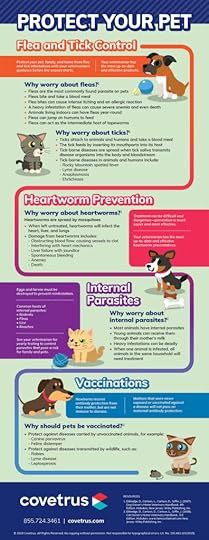4 Small Pests Harmful to Pets

As the
warmth of spring wiggles its way onto the calendar and into our lives, we as pet
parents need to be wary of the pesky pests
that can harm our beloved pets. Fleas, ticks, and mosquitoes carry diseases
that are not only harmful, but can be deadly, and bees and wasps can cause an
allergic reaction, just like in some people.
Bees,
Wasps and Other Stinging Insects
Like
humans, the sting from a wasp or bee can be painful to dogs and cats. Some pets
can even experience an allergic reaction to a sting. Fire ants, flies, and
other tiny pests can sting or bite. Therefore, be vigilant for such insects on
your patio, under the eaves of your house, and in your garden, and be mindful
of where your pet is in relation to where the insects are hovering. Symptoms of an allergic
reaction to a bug sting include head swelling, pale gums, excessive
drooling, and labored breathing. If you see such signs in your dog or cat after
being outdoors, contact your veterinarian immediately.

Fleas
These
tiny creatures are believed to be the most common external parasite
found on dogs and cats – and they can invade your home if not controlled. Fleas
cause itching and are known to be the most common cause of pet skin disease.
According to Web MD, though
tiny, these irritating pests can consume 15 times their own weight in blood,
causing anemia in a dog or cat. Fleas can also cause tapeworms. Therefore,
keeping these little pesky critters at bay is worth the time and investment.
Ticks
There
are
many types of ticks and tick-related diseases, according to the Centers for
Disease Control (CDC). Some are more confined to specific
regions of the United States. The CDC also notes that the spread of ticks is
increasing, as is a tick-borne disease known as Lyme
disease. Different tick species cause different diseases. For example, the
black-legged tick causes Lyme disease, and the brown dog tick, which is found
throughout the country, causes Rocky
Mountain Spotted Fever; humans are susceptible to both of these infections.
Therefore, check yourself and your animal thoroughly for these blood-sucking tiny
critters anytime you’ve been outside, and learn to remove ticks
properly to protect yourself and your furry friend.

Mosquitoes
Mosquitoes
also transmit diseases, some of which are deadly. One of the worst for our
pets, especially dogs, is heartworm.
Your dog may be infected but shows no symptoms at first. Cough and fatigue are
the first notable signs. This disease, once discovered, is difficult to combat
and some dogs don’t survive. Therefore, prevention is critical to keep your
furry friend safe. West
Nile Virus is another terrible disease animals and people can contract from
mosquitoes. Fur provides some protection from mosquitoes, but ears and noses
are vulnerable. Living and spending time near a water source makes you and your
furry friend more susceptible to swarms of these tiny pests.

Preventatives
Protection from stinging and biting insects, fleas, ticks, and mosquitoes is critical to keeping your pet safe and healthy. You can purchase preventive products from your vet directly or from a local pet supply store. You can find a good resource on such products here:
https://www.certapet.com/best-flea-tick-treatment-dogs/
Additionally,
experts
stress pet parents keep both a healthy, clean yard and home and frequently bath
dogs and cats and their beds.
Spring
brings more outdoor activities for both people and their pets and also brings
forth the onslaught of tiny creatures that seek the fur and skin of both animal
and human. Therefore, take the needed precautions to protect yourself and your
pet to better enjoy these warmer months.
For
an in-depth guide on tiny pests that can harm pets, visit these websites:
Pests That Affect Pets
http://www.petmd.com/flea-tick-survival-guide#.




